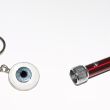If an anthropologist told me I clocked in 95 percent of my 25 years on earth fidgeting with my eyes, I'd believe them. Before my Lasik surgery in April I spent far too much time on treks to Duane Reade to buy industrial-sized bottles of Opti Free . Mornings were cut short searching for a tear in my contact lens like some crazed diamond dealer inspecting clarity, and nights were for cleaning my glasses, often with some unsuitable material ('Will this wool sweater do the trick?”), which only made them look as if they were coated in margarine. It all made for a charming persona, really, but I wanted to free up some life space to take up a hobby, or at the very least free up some cash to buy new mascaras.
More than anything else, though, I deeply longed for that kind of mythical, fuss free, oh-thanks-I-literally-just-put-moisturizer-on, kind of beauty. The kind of beauty that I associate with the French, who roll out of bed, spritz some Klorane on their roots, and seize the day and a cigarette, while I immediately seize my glasses so as not to run into an offending coffee table. My ideal beauty routine is one in which expressions like, “slap some rouge on your cheeks' and, “throw on some concealer' abound. The expression, “toss some contact lenses on your eyeballs' just doesn’t have the same ring to it.
While at the surface these gripes seem superficial, they conspired to make everyday living slightly more tedious. So after 15 years of severe myopia (I was significantly nearsighted, with a prescription of -7 in both eyes), I at last caved and went under the Lasik knife.
Cue Dr. Mandel, the best Lasik eye surgeon in New York. Dr. Mandel is known for being a pioneer of Intralase Lasik, which uses a laser to create a corneal flap instead of the more traditional blade method. The corneal flap (thinner than a strand of human hair) is then lifted and the cornea is reshaped using another laser (the VISX STAR S4 Excimer, for you laser enthusiasts) to correct nearsightedness, farsightedness, or astigmatism. Altogether, the procedure takes around 3-5 minutes per eye, and the surgery itself clocks in at around 10 minutes.
Initially, I was terrified that Lasik would leave me completely blind, but it turns out that there has been no incidence of blindness from Lasik surgery in the US. And even further, the risk of going blind from Lasik surgery is on par with going blind from wearing contact lenses.
With this fear out of the way, the rest of the one and a half hour consultation with Dr. Mandel was spent analyzing the shape and thickness of my corneas to determine if I was a candidate for Lasik, PRK (a slightly different procedure used for candidates who have thin corneas or dry eyes), or neither procedure. I then had my pupils dilated for another retinal examination, and lo and behold, after all the testing, I qualified for Lasik.
I scheduled my surgery for two weeks after my consultation (during which time contact lenses cannot be worn and lubricating eye drops must be frequently applied), and then promptly dumped my remaining Opti Free down the drain.
On the day of the surgery, my corneas were once again analyzed to obtain the most up-to-date measurements. Shortly after a brief stint in the relaxation room knocking my knees together, I headed over to the laser suite. I lay down in my chair, clutching a teddy bear while taking in the enormous whirring blinking machines in the surgical suite.
Disinfectant and numbing drops were added to my eyelid, and I was then asked to focus on a bright light as a lid holder was attached to my eye to keep it open while the other was taped shut (one eye is operated on a time). Afterwards, a suction device descended on my eyeball (which in reality was the most uncomfortable part of the procedure) and the Intralase Laser then created a flap using ultrashort laser pulses. If you want to know the plain truth, this was the most terrifying part of the procedure, as I temporarily went blind while the flap was lifted. But soon after, the VISX STAR S4 Excimer sculpted my corneas to perfection and my corneal flaps were re-attached, good as new.
After walking out of the Laser suite, I peered into the nearby courtyard and marveled at the clarity of the image before me, even more pristine than my eyesight had been with contact lenses; pigeons had never looked so good. I was then given some octogenarian-looking sunglasses to wear outside, and was immediately whisked away in a cab to take a six-hour beauty nap, doctor’s orders.
My vision was slightly blurred for the first day, but rapidly improved over the course of a week. My eyes felt a bit sandpapery for the first week, and I saw halos around bright lights at nighttime, but both symptoms have since disappeared completely. The most life-changing aspects of having Lasik are also the most mundane to the life-long haver of perfect vision: waking up and being able to see clearly; taking a nonchalant nap without worrying about the dreaded blurred vision; falling asleep on an overnight plane without the pit-stop to the bathroom to remove my lenses; and having more time to play around with my eyeliner and mascara in the morning. In addition, my vision is 20/15, which means I now meet the vision qualifications to become an Air Force Pilot, if I ever wanted a career change.
—Caroline Solomon
Caroline Solomon is a freelance writer based in Brooklyn. Photos by Tom Newton.




